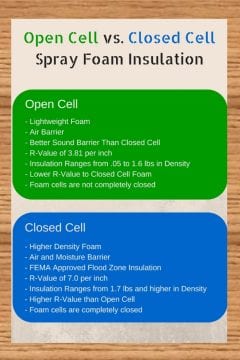
Open vs. Closed Cell Foam
We get this question all the time when we talk to people about their insulation choices.
Both open and closed cell spray foam insulate by trapping air or gas in a plastic matrix, but that’s where the similarities end.
Open-Cell

Open-cell foam costs slightly less for the same thickness, but offers a lower R-value. The blowing agent used to install open-cell insulation is water, which reacts with air to become carbon dioxide. Because CO2 expands quickly, the bubbles tend to burst before the plastic sets — hence “open cell” — producing a spongy, lightweight foam. Because the open cell structure allows some vapor to pass through, open-cell foam is a good choice in hot, humid climates, and under roof sheathing, such as in conditioned attics, where water vapor caught between insulation and sheathing could promote wood rot.
Closed-Cell

Unlike open-cell foam, closed-cell foam uses liquid chemical blowing agents. These gasses expand as they are applied, but not as quickly as CO2, allowing the polyurethane plastic to set before the bubbles burst. This yields dense foam weighing nearly 2 pounds per cubic foot and without the capillary characteristics of open-cell, it remains impermeable. The blowing agents perform like the inert gasses between the panes of high-performance windows, adding to the insulating qualities of the foam. Unlike open-cell foam, closed-cell foam rarely requires any trimming, with little or no jobsite waste.
Closed-cell’s obvious advantages compensate for its slightly higher price tag. It provides both a vapor and an air barrier, and offers an aged R-value of a whopping 6.5 per inch. Due to its dense, glue-like consistency, it remains very strong, increasing the racking strength of walls by as much as 300%, according to the National Association of Home Builders Research Center. (These structural properties are not acknowledged by current building codes, so you can’t reduce structural bracing.) Because water doesn’t penetrate or degrade the product, the Federal Emergency Management Agency recommends closed-cell for flood regions.
Spray foam costs more than traditional insulation but it can be a very cost effective way to build high-performance homes and meet stricter energy codes.

